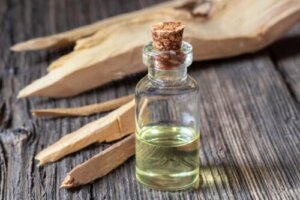Sandalwood Oil: Benefits, Uses and Side Effects


Reviewed and approved by the pharmacist Franciele Rohor de Souza
Sandalwood oil is an oil that’s obtained from the wood and roots of the tree called Santalum album. It’s mainly cultivated in India, but also in Indonesia.
Its bark is smooth and grayish-brown, while the wood has yellow ochre tones. In addition, it has small purple or pink flowers.
The plant has an important significance in Hindu and Buddhist rituals. In these rituals, it’s often used as incense. However, beyond that, its oil has been used in Ayurvedic medicine to treat some health problems.
Are you interested in knowing more about it? Below, we’ll take a look at all its uses.
Benefits of sandalwood oil
Sandalwood essential oil has been used for various therapeutic purposes, especially in Ayurvedic medicine and traditional Chinese medicine. However, many of its applications are based only on anecdotal evidence and have not been proven by scientific studies. So, what are its potential benefits?
Anxiety
Due to its volatile compound content, sandalwood oil has been used in aromatherapy to balance the nervous system and reduce anxiety. Its inhalation through a diffuser causes a relaxing effect that may manifest itself in an improved mood.
In fact, a small study reported in Worldviews on Evidence-Based Nursing reported that an aromatherapy session with sandalwood, lavender, peppermint, and orange was helpful in decreasing anxiety in a group of women undergoing breast biopsy.
We think you may also enjoy reading this article: What Are Essential Oils and How and Why Do They Work?
Wound healing
Traditionally, this oil has been used on minor skin wounds to reduce the risk of infection and promote healing. In a study by researchers at the Ruhr-Universität Bochum in Germany, it was determined that the skin has a receptor for sandalwood. Once activated, it enhances cell proliferation to speed recovery.

Anti-inflammatory
Research shared in Indian Dermatology Online Journal suggests that sandalwood has the potential to be an anti-inflammatory agent. This is because it can alter cell signaling in the body. In this way, it aids in treating the symptoms of inflammatory skin disorders such as psoriasis and atopic dermatitis.
Antitumor properties
Sandalwood oil’s main active compound, alpha-santalol, has been investigated for its potential to destroy cancer cells. In a study shared in Archives of Biochemistry and Biophysics, it was determined that this component helps induce cell death in skin cancer cells.
Despite these findings, there is insufficient evidence to consider this product as a treatment for cancer.
Traditional uses of sandalwood oil
Apart from the above benefits, sandalwood oil has been used as a therapeutic agent for other health conditions. And while it’s not a first-choice treatment for disease, it’s generally well tolerated and can be considered an adjunct.
What are its main uses?
- Skin diseases. In particular, its anti-inflammatory and antimicrobial properties support the treatment of acne, warts, and psoriasis.
- Urinary tract infections. It has antiseptic and diuretic properties that support the relief of cystitis and urethritis.
- Respiratory diseases. Its volatile compounds contribute to clearing the respiratory tract in case of colds, flu, bronchitis, and sinusitis.
- Circulatory problems. Topically, it’s used as a venous tonic to support the treatment of varicose veins and hemorrhoids.
- Oral infections. Due to its antibacterial and anti-inflammatory qualities, it helps to reduce infections of the mouth and gums.
- Nail fungus. Externally, it also helps to control onychomycosis.
The risks and possible side effects of sandalwood oil
In general, sandalwood oil is safe for most people as long as it’s used correctly and in the proper dosage. It’s usually tolerated quite well.
However, given the lack of scientific studies, it’s recommended to avoid it in the following cases:
- Pregnancy and lactation
- Children under six years old
- People about to undergo surgery (consult your doctor first)
- Patients with gastritis, liver disease, and neurological pathologies
On its own, the essential oil can be irritating to the skin. For this reason, it’s best to mix it with a carrier oil, such as coconut, olive, or almond oil.
In addition, it’s advisable to do a patch test to rule out any possible reactions. To do this, simply place a small amount on an area of the skin. If there’s no irritation or discomfort after 12 hours, it can be applied without any problem.
The main application of sandalwood is on the skin. Anecdotal evidence almost always speaks to improvements in dermatological conditions.
How to choose a high-quality sandalwood oil?
When purchasing sandalwood oil in the market, it is convenient to verify that it complies with certain characteristics. In this way, its purity and properties are guaranteed. First of all, it must have a minimum alcohol-free level of 90%.
The label must specify that it’s derived from the Santalum album species. If it has names such as “scented oil” or “oil with sandalwood essence,” it’s likely to be synthetic versions with mixtures of other oils.
Like this article? You may also like to read: Bergamot Essential Oil: Benefits and Possible Side Effects
How to use this oil at home?
Sandalwood essential oil can be used in aromatherapy, applied in massages, or in capsules. The latter usually comes in presentations of 20 to 50 mg. It’s recommended to take 3 or 4 a day, depending on the ailment.
Other ways to use it are the following:
- In aroma diffusers.
- Mixed with almond or coconut oil to massage the skin.
- Added in perfumes, body creams, or lotions (about 3 to 5 drops).
- In boiling water (vapors can be inhaled in case of respiratory problems).
What to remember about sandalwood oil
To date, there are no clinical studies that prove all the benefits attributed to sandalwood oil. Even so, it’s a well-tolerated product that can be used as a complementary remedy. In aromatherapy and topically, it’s a good option to relax the body and mind.
In addition to the above, its components favor skin care and help mitigate symptoms of common ailments, such as colds. Have you already tried it at home?
All cited sources were thoroughly reviewed by our team to ensure their quality, reliability, currency, and validity. The bibliography of this article was considered reliable and of academic or scientific accuracy.
- Trambert R, Kowalski MO, Wu B, Mehta N, Friedman P. A Randomized Controlled Trial Provides Evidence to Support Aromatherapy to Minimize Anxiety in Women Undergoing Breast Biopsy. Worldviews Evid Based Nurs. 2017 Oct;14(5):394-402. doi: 10.1111/wvn.12229. Epub 2017 Apr 10. PMID: 28395396.
- Sandalwood scent facilitates wound healing and skin regeneration. (2014).
eurekalert.org/pub_releases/2014-07/rb-ssf070814.php -
Rajsmita B, Keshavamurthy V. Re-discovering Sandalwood: Beyond Beauty and Fragrance. Indian Dermatol Online J. 2019 May-Jun;10(3):296-297. doi: 10.4103/idoj.IDOJ_357_18. PMID: 31149575; PMCID: PMC6536050.
-
Dickinson, S. E., Olson, E. R., Levenson, C., Janda, J., Rusche, J. J., Alberts, D. S., & Bowden, G. T. (2014). A novel chemopreventive mechanism for a traditional medicine: East Indian sandalwood oil induces autophagy and cell death in proliferating keratinocytes. In Archives of Biochemistry and Biophysics (Vol. 558, pp. 143–152). Elsevier BV. https://doi.org/10.1016/j.abb.2014.06.021
- Moy RL, Levenson C. Sandalwood Album Oil as a Botanical Therapeutic in Dermatology. J Clin Aesthet Dermatol. 2017 Oct;10(10):34-39. Epub 2017 Oct 1. PMID: 29344319; PMCID: PMC5749697.
This text is provided for informational purposes only and does not replace consultation with a professional. If in doubt, consult your specialist.








